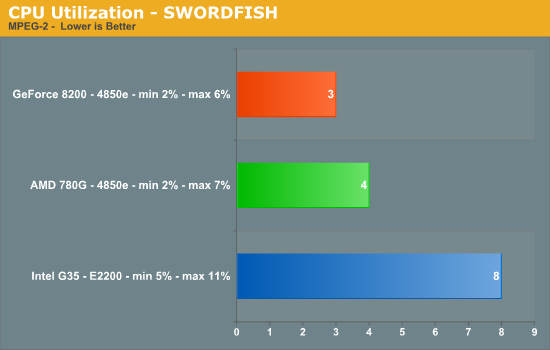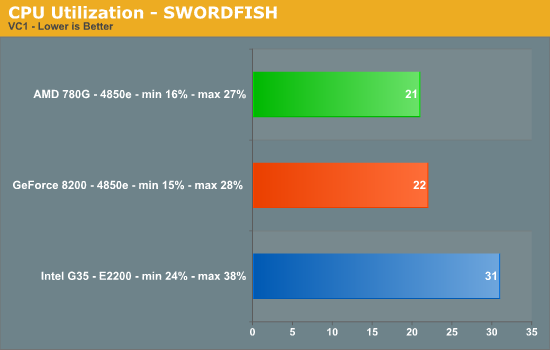AMD 780G: Preview of the Best Current IGP Solution
by Gary Key on March 10, 2008 12:00 PM EST- Posted in
- CPUs
Testing Notes
Our image quality tests today consists of still screenshots from several movies in our collection, actually the primary criteria were movies that offered decent bitrates and were screen capture friendly under DRM infested Vista. While we tried to capture the exact moment within a frame to compare the 780G to the G35/GF8200, this was not always possible. However, we did our best to capture the screenshots on the same frame but at times; the capture process grabbed the beginning of the frame or the trailing end.
In the end, we feel like the process is close enough to give you an indication to any differences between the images. Obviously, we cannot show the reference image but will comment as to which screen shot best represented the reference image on our home theater system. We find measuring video output quality in this manner a subjective process to some degree, as at times we liked an image that did not match the reference screenshot better than the one that did. Considering that fact, we decided to bring eight people in to give us their opinions during playback sequences and then still-shot reviews.
We utilized PowerDVD 7.3 (build 3610 utilized, 3730 in testing) for playback with all settings on auto, except we enabled hardware acceleration within the application. We measured CPU utilization and bitrate results with the Vista Task Manager and PowerDVD Info applications respectively. We took readings every five minutes and averaged the results at the end of the movie. Movies were played back in full screen mode at their native resolutions with the desktop set to 1920x1200. We will show discrete card results in our next article. However, the HD 3450 provided results that were just a few percent better than the HD 3200 with the released 8.3 driver set.
Audio settings selected were Dolby Digital 5.1, DTS 5.1, or two-channel LPCM where applicable. Unlike the 780G, the G35 and GeForce 8200 fully supports multi-channel LPCM output and we will comment on results with either LPCM 5.1 or Dolby TrueHD decoded streams (via PowerDVD) where applicable.
We calibrated both systems on our Gateway XHD3000 monitor to ensure the color palettes were set equally. Fine tuning the control panel settings for each of the test setups can and will improve the picture quality but we will leave that up to the user to decide their preferences. We played back the movie sequences on the Gateway monitor for initial viewing and judging. We proceeded to output the same movie sequences on our calibrated Samsung 61" (HL-T6187S) DLP set utilizing the same control panel and PowerDVD settings to view the images in an HT setting.
We then utilized our test setups to pass through the image and audio via HDMI to our Pioneer Elite VSX-94THX A/V receiver. Using the receiver as a "repeater", we output the native signal (our preferred method to PWDVD) to our HT setup (7.1 audio/Samsung 61” DLP) for our test subjects. We will list their preferences in our comments section. We will also warn you in advance that the original images are generally 2MB to 3MB in size if you decide to download them.
MPEG 2 Video Quality - SWORDFISH
We are utilizing the movie SWORDFISH from Warner Brothers, what else can we say, we still like seeing Halle Berry in the lounge chair. This movie offers bitrate levels that averaged 5.4 Mb/s to 8.1 Mb/s on average. In our particular test scene, John Travolta is drinking a cup of coffee in a close up shot that highlights skin tones along with reflections off the cup and background objects.
 780G – Click to Enlarge |
 G35 – Click to Enlarge
|
 GeForce 8200 – Click to Enlarge |
The differences in the images are minor but the G35 appears to have slightly deeper colors along with a slight edge in sharpness while the GeForce 8200 offers additional contrast and a better background image, but being darker overall. However, the 780G image was faithful to the reference image during playback tests. Our test audience placed 4 votes for the 780G, 2 for the G35, and 2 for the GeForce 8200.

CPU utilization during playback favors the 780G and GeForce 8200 on average by 4%. This was surprising to us as the G35 does not offer full hardware decode capabilities for MPEG-2 playback. However, we never had a problem with playback in this title and others such as Cars and Spiderman 3.
VC1 Video Quality - SWORDFISH
SWORDFISH is not a very demanding movie in 1080P playback but the image screenshots should give a good indication to the improvement when going from MPEG-2 to VC1. This movie offers bitrate levels that averaged 15.7 Mb/s to 25.2 Mb/s on average. Once again, we utilize the coffee shop test scene.
 780G – Click to Enlarge |
 G35 – Click to Enlarge |
 GeForce 8200 – Click to Enlarge |
The differences in the images are once again minor but this time the 780G appears to have better skin tones while sharpness and overall color palette seems to favor the G35. We thought the GeForce 8200 image was slightly on the flat side when comparing facial details but had the best background details. The 780G image was more faithful to the reference image during playback tests. The 780G garnered 3 votes, 3 to the G35, and 2 for the GeForce 8200.

CPU utilization during playback favors the GeForce 8200 and 780G by a several percent even though the G35 offers hardware accelerated decoding of the VC1 format. There were not any judder or stuttering problems on any of the platforms during playback.










49 Comments
View All Comments
greenfuzion - Thursday, April 17, 2008 - link
http://www.youtube.com/watch?v=_l2e0mf3CcA">http://www.youtube.com/watch?v=_l2e0mf3CcASchugy - Tuesday, March 11, 2008 - link
The new AMD chipset is a good choice for a MythTV frontend and it will play normal mpeg2 tv flawlessly.But I won't need any HD capabilities because video players like kaffeine or mplayer won't support HDCP crap or any hardware accelleration.
With the lousy closed source nVIDIA linux driver not supporting pureview I can't even watch the unencrypted EA Burnout Paradise demo video fullscreen (VIDEO: [avc1] 1280x720 24bpp) without any performance problems. But I think a Sempron 3000+ SOA and a 7600GT should be enough for this resolution far away from full HD.
I won't spend any money for HD hardware or HD content because there's no sense in it.
najames - Tuesday, March 11, 2008 - link
Since these boards are intended as media PCs, I think you should be doing thorough testing of the onboard LAN. My Biostar TA690G does a decent job on gigabit, my Gigabyte GA-MA69GM-S2H sucked at sending, ok in receiving. Intel Pro1000 PCI-e x1 replacement card did a lot better on the Gigabyte, although I still question the boards throughput. I have done a LOT of LAN testing on Linux for a building server. This kind of stuff needs to be checked, writing to a single WD 640GB drive.ftp> put mint.iso
local: mint.iso remote: mint.iso
200 PORT command successful. Consider using PASV.
150 Ok to send data.
226 File receive OK.
722104320 bytes sent in 6.41 secs (109965.8 kB/s)
ftp> quit
yehuda - Wednesday, March 12, 2008 - link
Gigabyte's 690G and 690V boards suck at network performance because they use a PCI controller as upposed to a PCI Express controller in most other boards.Fortunately, the GA-MA78GM-S2H is free from this drawback. You can check the network results here:
http://www.techreport.com/articles.x/14261/13">http://www.techreport.com/articles.x/14261/13
That said, I can't explain your comment on questionable throughput with the replacement PCI-e card.
rhofmann - Tuesday, March 11, 2008 - link
1080p HD decode is great, but in my experience I've found that the de-interlacing required by 1080i broadcast HD content has been an Achilles heel for HTPC output with integrated graphics.jamawass - Tuesday, March 11, 2008 - link
Never thought I'd see the day when Tomshardware actually published a better review than Anandtech. I don't understand how a review article on AMD 780g ends with a paragraph on an Intel chipset talking about strengths in"office applications", heck a igp chipset 10 yrs ago was good in office applications.This is the best IGP chipset currently and the article should have stated that categorically instead of using lame " AMD got it almost right". What use is lpcm audio when the image is paused and juddering on your screen?
Power consumption, sound use are all relevant when reviewing a platform like this I just didn't see the empahsis on these in this article.
TheJian - Tuesday, March 11, 2008 - link
I was surprised by TomsHardware too. I haven't put much stock in their site for years (since a ways before they soldout). In the beginning Tom Pabst did an excellent job HIMSELF. But now it's just his name on the site. I expected to read their review over here, and Anandtech's review over at Toms...LOL. Maybe I'll have to start paying more attention to Toms. Jeez, did I say that out loud? Or am I just thinking it... :)Toms review was definitely shooting straight. Totally agree that Audio (any kind not just over HDMI) can't get me to lean towards Intel if the picture sucks to begin with. What's the point in Hi-Def if it looks like crap? OH wait...That's right it still sounds good! LOL. Whatever...
gochichi - Tuesday, March 11, 2008 - link
Refurbished Dell Vostro 400 desktop with a superior Intel Quad chip, Vista Home Premium, 2GB RAM (upgradeable), 160GB HDD, DVD+/-, 8300 GS (which should do just about as well, very very close I imagine), keyboard, mouse and some sense of synergy. Meaning, you get a keyb/mouse/case that match in some way... even if the thing is not particularly small, it's pretty small and high quality looking than most reasonably priced cases.Heck, forget price, only a few cases are passable PERIOD. Vista's pricing even the so-called "OEM" price really messes things up also.
The Vostro mentioned above, which would outperform any Phenom is $459.00 ready to go... already assembled, perfect matches etc.
Before you ask me... why don't I just buy it if I like the deal so much? I just might, I just might is the answer.
Zstream - Tuesday, March 11, 2008 - link
Utter rubish! A Vostro 400 huh?Lets go to dell's site. A Vostro 400 with Intel® Core™2 Duo Proc E4500 (2.20GHz, 2MB L2 Cache, 800FSB), one gig of ram, dvd-rom, 160gb hard drive...
I would purchase a 780g/tri-core htpc over this any day of the week.
gochichi - Tuesday, March 11, 2008 - link
Did you ever consider that you can't find the unit I'm talking about anymore.I said nothing about a 2.2Ghz Duo anything. I was talking about a QUAD 2.4 Ghz with a small HDD, 2GB of RAM and a remedial video card (that would perform about as well as the 780G, maybe a little better it was a 8300 GS).
Dell WAS selling 2.4Ghz quad refurbs as duos... but I don't know if that's changed.
All of this is really irrelevant. I guess the broader point is that building a computer from scratch blows for a number of reasons (unless you're really going to spend in top end stuff).
1. Getting a decent case/PSU for under $100.00 is a feat, and even then it's too much.
2. Vista or any other MS system is over priced.
About the 780G, my first reaction was: "it's only $70.00" and I started going from there. But you know what? At the end of the day, you're really saving $30.00 on what a remedial 8400 GS would cost. $30.00 when you're building from scratch just isn't that much. AMD has provided a decent part for OEMs though. Hopefully they can deliver.
As for the Vostro 400 w/ Quad and Vista Home Premium for $469.00 hopefully I'll be able to find it again and buy it. $40.00 upgrades it to 4GB of RAM and you can actually put any video card you want in that thing (just one though obviously). So 9600GT down the line, or wait it out and get something next gen.
Part of the advantage of building from scratch is overclocking. But no matter how much you overclock a Phenom, it's still pretty much not as good as a basic 2.4Ghz intel Quad. Those things have been around forever. Intel is totally yawning as they pummel AMD. Overclocking also means even pricier parts and headache and I'm just not seeing how you could possibly beat the bang/$ of the Vostro.
Now, that's me. You want to build a system based AMD and this chipset, it sounds like fun... but it doesn't sound smart.